Report: Professional Practice Portfolio Development and Analysis
VerifiedAdded on 2020/06/04
|10
|3065
|42
Report
AI Summary
This report delves into the development and analysis of a professional practice portfolio (PPP), a crucial tool for nurses to showcase professional growth and learning. The report outlines the essential components of a PPP, including achievements, competencies, and development plans. It critically analyzes the use of PPPs, highlighting their benefits in presenting skills and experiences, while also addressing potential issues and limitations, such as lack of standardization. The report further differentiates between management and leadership competencies, emphasizing their distinct roles in professional practice. A case study from a student nurse's clinical placement is presented, illustrating practical application of these concepts. Finally, the report provides an overview of a peak professional nursing organization and its relevance to the PPP framework. The report underscores the importance of a well-developed portfolio in demonstrating professional expertise and facilitating career advancement in nursing.
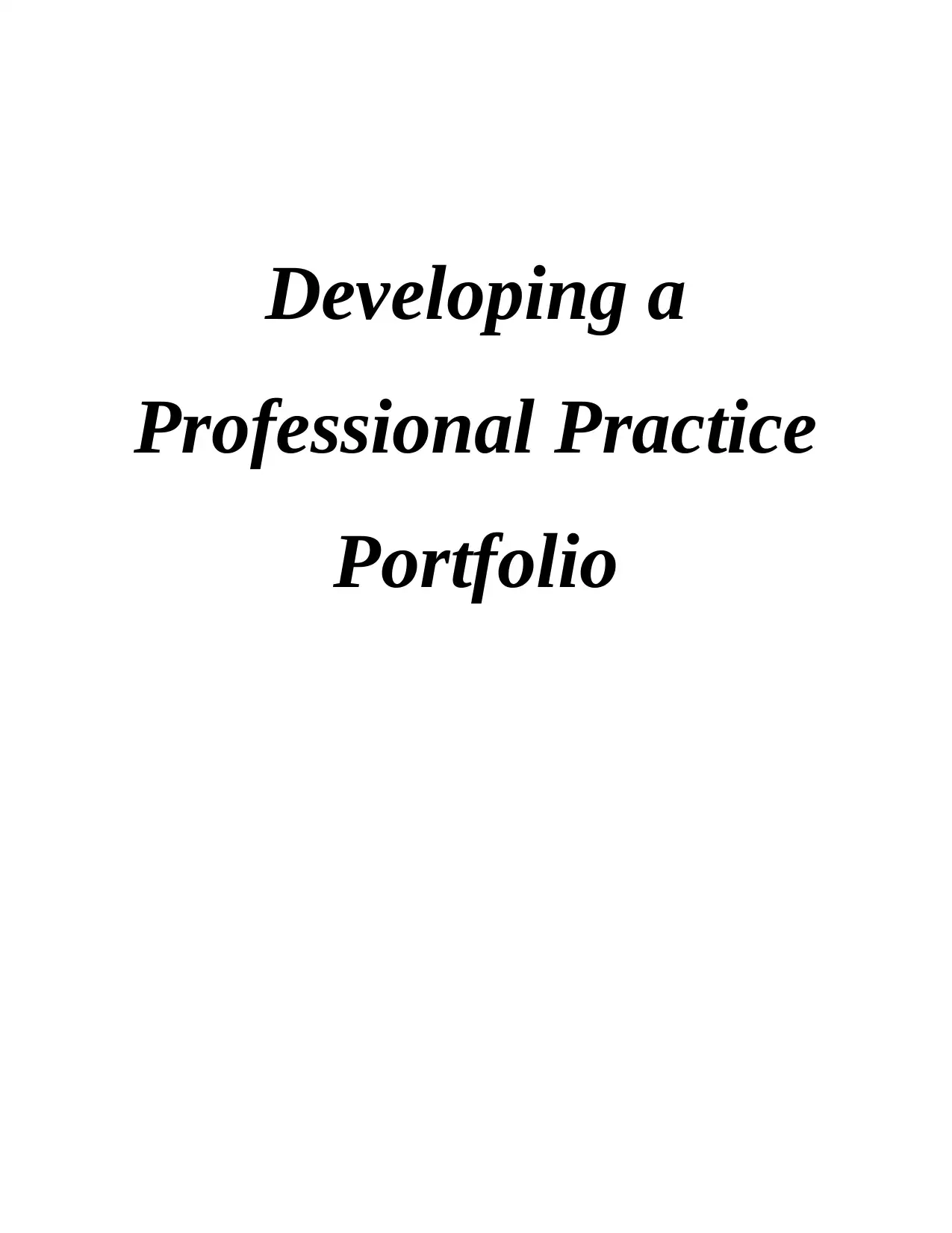
Developing a
Professional Practice
Portfolio
Professional Practice
Portfolio
Paraphrase This Document
Need a fresh take? Get an instant paraphrase of this document with our AI Paraphraser
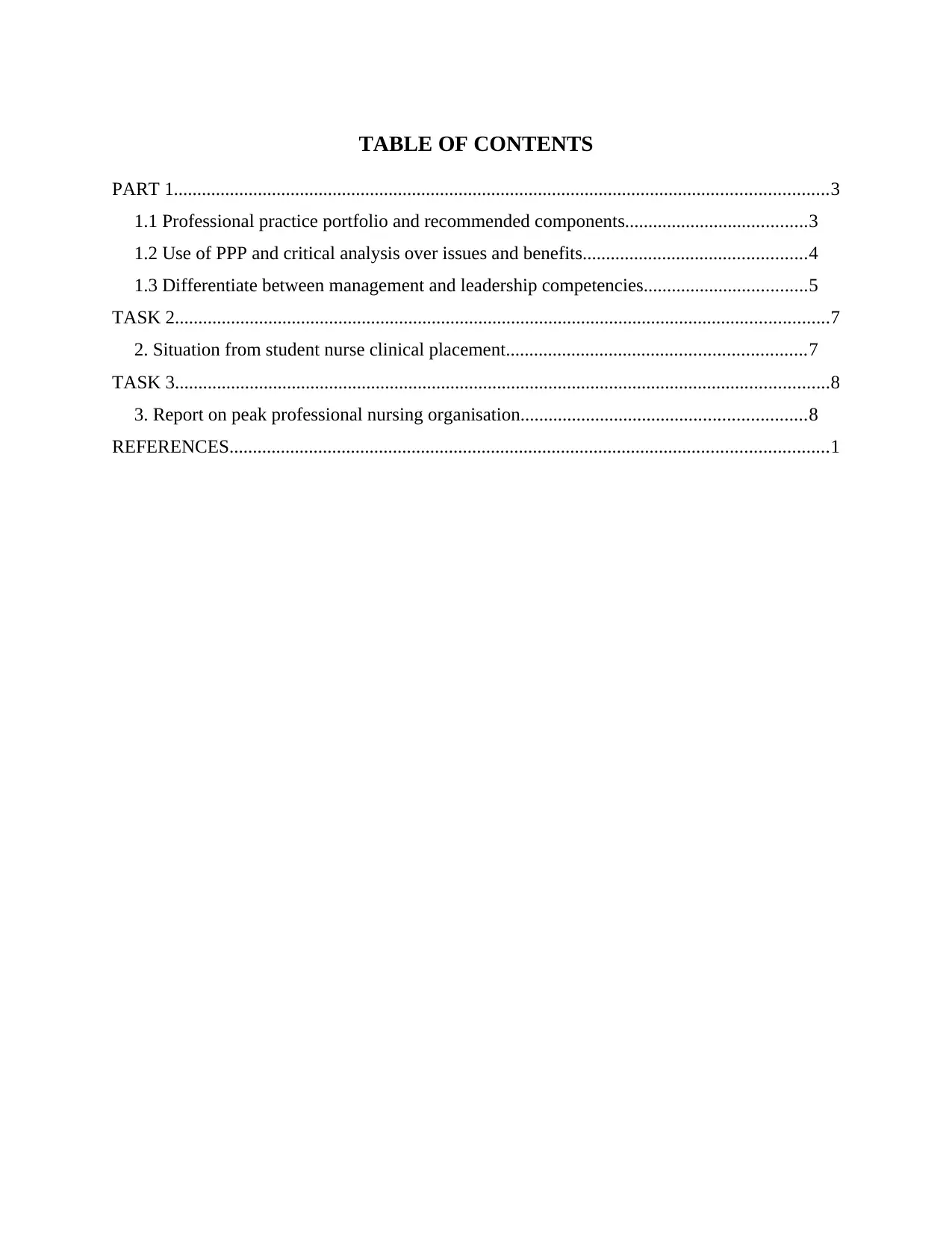
TABLE OF CONTENTS
PART 1............................................................................................................................................3
1.1 Professional practice portfolio and recommended components.......................................3
1.2 Use of PPP and critical analysis over issues and benefits................................................4
1.3 Differentiate between management and leadership competencies...................................5
TASK 2............................................................................................................................................7
2. Situation from student nurse clinical placement................................................................7
TASK 3............................................................................................................................................8
3. Report on peak professional nursing organisation.............................................................8
REFERENCES................................................................................................................................1
PART 1............................................................................................................................................3
1.1 Professional practice portfolio and recommended components.......................................3
1.2 Use of PPP and critical analysis over issues and benefits................................................4
1.3 Differentiate between management and leadership competencies...................................5
TASK 2............................................................................................................................................7
2. Situation from student nurse clinical placement................................................................7
TASK 3............................................................................................................................................8
3. Report on peak professional nursing organisation.............................................................8
REFERENCES................................................................................................................................1
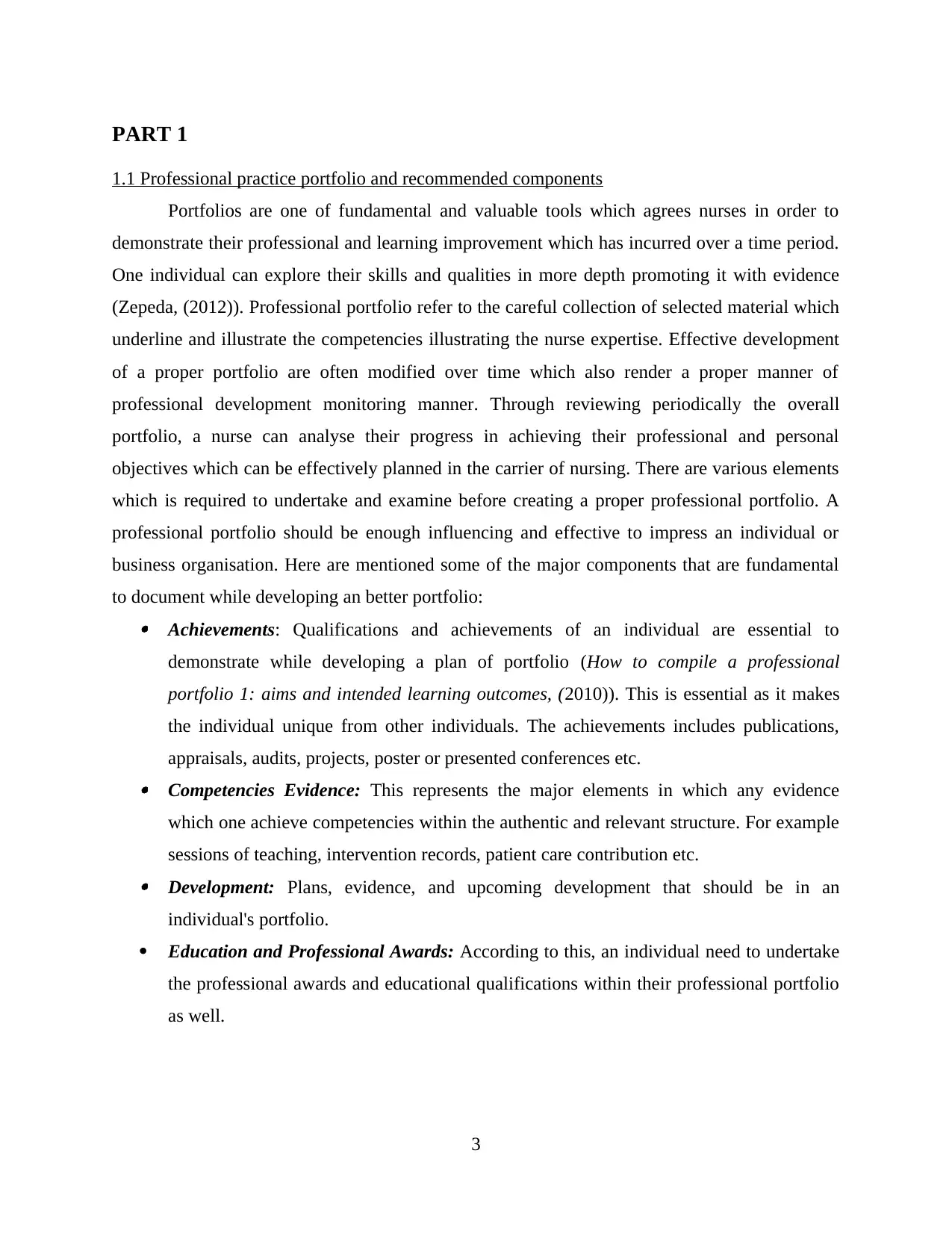
PART 1
1.1 Professional practice portfolio and recommended components
Portfolios are one of fundamental and valuable tools which agrees nurses in order to
demonstrate their professional and learning improvement which has incurred over a time period.
One individual can explore their skills and qualities in more depth promoting it with evidence
(Zepeda, (2012)). Professional portfolio refer to the careful collection of selected material which
underline and illustrate the competencies illustrating the nurse expertise. Effective development
of a proper portfolio are often modified over time which also render a proper manner of
professional development monitoring manner. Through reviewing periodically the overall
portfolio, a nurse can analyse their progress in achieving their professional and personal
objectives which can be effectively planned in the carrier of nursing. There are various elements
which is required to undertake and examine before creating a proper professional portfolio. A
professional portfolio should be enough influencing and effective to impress an individual or
business organisation. Here are mentioned some of the major components that are fundamental
to document while developing an better portfolio: Achievements: Qualifications and achievements of an individual are essential to
demonstrate while developing a plan of portfolio (How to compile a professional
portfolio 1: aims and intended learning outcomes, (2010)). This is essential as it makes
the individual unique from other individuals. The achievements includes publications,
appraisals, audits, projects, poster or presented conferences etc. Competencies Evidence: This represents the major elements in which any evidence
which one achieve competencies within the authentic and relevant structure. For example
sessions of teaching, intervention records, patient care contribution etc. Development: Plans, evidence, and upcoming development that should be in an
individual's portfolio.
Education and Professional Awards: According to this, an individual need to undertake
the professional awards and educational qualifications within their professional portfolio
as well.
3
1.1 Professional practice portfolio and recommended components
Portfolios are one of fundamental and valuable tools which agrees nurses in order to
demonstrate their professional and learning improvement which has incurred over a time period.
One individual can explore their skills and qualities in more depth promoting it with evidence
(Zepeda, (2012)). Professional portfolio refer to the careful collection of selected material which
underline and illustrate the competencies illustrating the nurse expertise. Effective development
of a proper portfolio are often modified over time which also render a proper manner of
professional development monitoring manner. Through reviewing periodically the overall
portfolio, a nurse can analyse their progress in achieving their professional and personal
objectives which can be effectively planned in the carrier of nursing. There are various elements
which is required to undertake and examine before creating a proper professional portfolio. A
professional portfolio should be enough influencing and effective to impress an individual or
business organisation. Here are mentioned some of the major components that are fundamental
to document while developing an better portfolio: Achievements: Qualifications and achievements of an individual are essential to
demonstrate while developing a plan of portfolio (How to compile a professional
portfolio 1: aims and intended learning outcomes, (2010)). This is essential as it makes
the individual unique from other individuals. The achievements includes publications,
appraisals, audits, projects, poster or presented conferences etc. Competencies Evidence: This represents the major elements in which any evidence
which one achieve competencies within the authentic and relevant structure. For example
sessions of teaching, intervention records, patient care contribution etc. Development: Plans, evidence, and upcoming development that should be in an
individual's portfolio.
Education and Professional Awards: According to this, an individual need to undertake
the professional awards and educational qualifications within their professional portfolio
as well.
3
⊘ This is a preview!⊘
Do you want full access?
Subscribe today to unlock all pages.

Trusted by 1+ million students worldwide
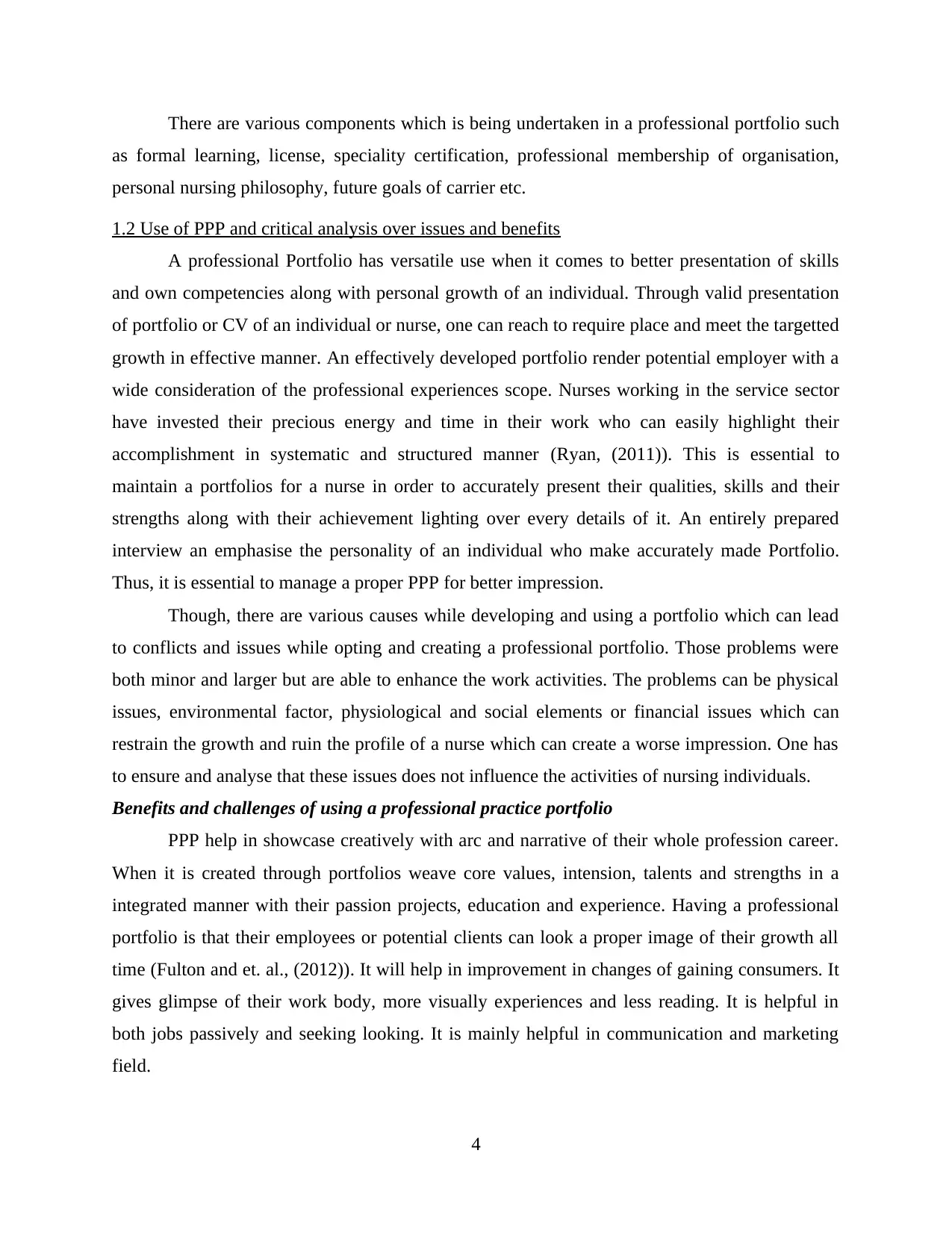
There are various components which is being undertaken in a professional portfolio such
as formal learning, license, speciality certification, professional membership of organisation,
personal nursing philosophy, future goals of carrier etc.
1.2 Use of PPP and critical analysis over issues and benefits
A professional Portfolio has versatile use when it comes to better presentation of skills
and own competencies along with personal growth of an individual. Through valid presentation
of portfolio or CV of an individual or nurse, one can reach to require place and meet the targetted
growth in effective manner. An effectively developed portfolio render potential employer with a
wide consideration of the professional experiences scope. Nurses working in the service sector
have invested their precious energy and time in their work who can easily highlight their
accomplishment in systematic and structured manner (Ryan, (2011)). This is essential to
maintain a portfolios for a nurse in order to accurately present their qualities, skills and their
strengths along with their achievement lighting over every details of it. An entirely prepared
interview an emphasise the personality of an individual who make accurately made Portfolio.
Thus, it is essential to manage a proper PPP for better impression.
Though, there are various causes while developing and using a portfolio which can lead
to conflicts and issues while opting and creating a professional portfolio. Those problems were
both minor and larger but are able to enhance the work activities. The problems can be physical
issues, environmental factor, physiological and social elements or financial issues which can
restrain the growth and ruin the profile of a nurse which can create a worse impression. One has
to ensure and analyse that these issues does not influence the activities of nursing individuals.
Benefits and challenges of using a professional practice portfolio
PPP help in showcase creatively with arc and narrative of their whole profession career.
When it is created through portfolios weave core values, intension, talents and strengths in a
integrated manner with their passion projects, education and experience. Having a professional
portfolio is that their employees or potential clients can look a proper image of their growth all
time (Fulton and et. al., (2012)). It will help in improvement in changes of gaining consumers. It
gives glimpse of their work body, more visually experiences and less reading. It is helpful in
both jobs passively and seeking looking. It is mainly helpful in communication and marketing
field.
4
as formal learning, license, speciality certification, professional membership of organisation,
personal nursing philosophy, future goals of carrier etc.
1.2 Use of PPP and critical analysis over issues and benefits
A professional Portfolio has versatile use when it comes to better presentation of skills
and own competencies along with personal growth of an individual. Through valid presentation
of portfolio or CV of an individual or nurse, one can reach to require place and meet the targetted
growth in effective manner. An effectively developed portfolio render potential employer with a
wide consideration of the professional experiences scope. Nurses working in the service sector
have invested their precious energy and time in their work who can easily highlight their
accomplishment in systematic and structured manner (Ryan, (2011)). This is essential to
maintain a portfolios for a nurse in order to accurately present their qualities, skills and their
strengths along with their achievement lighting over every details of it. An entirely prepared
interview an emphasise the personality of an individual who make accurately made Portfolio.
Thus, it is essential to manage a proper PPP for better impression.
Though, there are various causes while developing and using a portfolio which can lead
to conflicts and issues while opting and creating a professional portfolio. Those problems were
both minor and larger but are able to enhance the work activities. The problems can be physical
issues, environmental factor, physiological and social elements or financial issues which can
restrain the growth and ruin the profile of a nurse which can create a worse impression. One has
to ensure and analyse that these issues does not influence the activities of nursing individuals.
Benefits and challenges of using a professional practice portfolio
PPP help in showcase creatively with arc and narrative of their whole profession career.
When it is created through portfolios weave core values, intension, talents and strengths in a
integrated manner with their passion projects, education and experience. Having a professional
portfolio is that their employees or potential clients can look a proper image of their growth all
time (Fulton and et. al., (2012)). It will help in improvement in changes of gaining consumers. It
gives glimpse of their work body, more visually experiences and less reading. It is helpful in
both jobs passively and seeking looking. It is mainly helpful in communication and marketing
field.
4
Paraphrase This Document
Need a fresh take? Get an instant paraphrase of this document with our AI Paraphraser
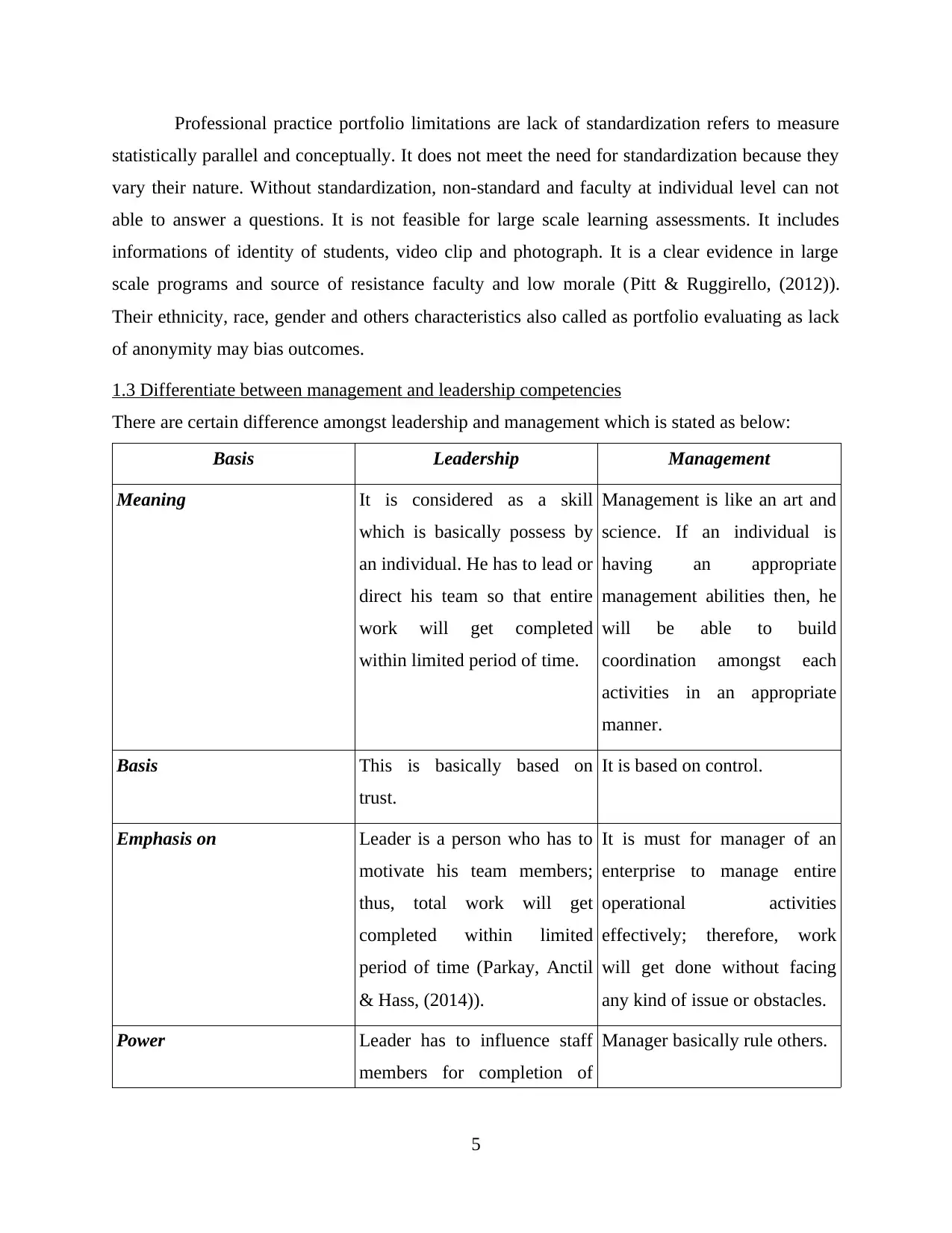
Professional practice portfolio limitations are lack of standardization refers to measure
statistically parallel and conceptually. It does not meet the need for standardization because they
vary their nature. Without standardization, non-standard and faculty at individual level can not
able to answer a questions. It is not feasible for large scale learning assessments. It includes
informations of identity of students, video clip and photograph. It is a clear evidence in large
scale programs and source of resistance faculty and low morale (Pitt & Ruggirello, (2012)).
Their ethnicity, race, gender and others characteristics also called as portfolio evaluating as lack
of anonymity may bias outcomes.
1.3 Differentiate between management and leadership competencies
There are certain difference amongst leadership and management which is stated as below:
Basis Leadership Management
Meaning It is considered as a skill
which is basically possess by
an individual. He has to lead or
direct his team so that entire
work will get completed
within limited period of time.
Management is like an art and
science. If an individual is
having an appropriate
management abilities then, he
will be able to build
coordination amongst each
activities in an appropriate
manner.
Basis This is basically based on
trust.
It is based on control.
Emphasis on Leader is a person who has to
motivate his team members;
thus, total work will get
completed within limited
period of time (Parkay, Anctil
& Hass, (2014)).
It is must for manager of an
enterprise to manage entire
operational activities
effectively; therefore, work
will get done without facing
any kind of issue or obstacles.
Power Leader has to influence staff
members for completion of
Manager basically rule others.
5
statistically parallel and conceptually. It does not meet the need for standardization because they
vary their nature. Without standardization, non-standard and faculty at individual level can not
able to answer a questions. It is not feasible for large scale learning assessments. It includes
informations of identity of students, video clip and photograph. It is a clear evidence in large
scale programs and source of resistance faculty and low morale (Pitt & Ruggirello, (2012)).
Their ethnicity, race, gender and others characteristics also called as portfolio evaluating as lack
of anonymity may bias outcomes.
1.3 Differentiate between management and leadership competencies
There are certain difference amongst leadership and management which is stated as below:
Basis Leadership Management
Meaning It is considered as a skill
which is basically possess by
an individual. He has to lead or
direct his team so that entire
work will get completed
within limited period of time.
Management is like an art and
science. If an individual is
having an appropriate
management abilities then, he
will be able to build
coordination amongst each
activities in an appropriate
manner.
Basis This is basically based on
trust.
It is based on control.
Emphasis on Leader is a person who has to
motivate his team members;
thus, total work will get
completed within limited
period of time (Parkay, Anctil
& Hass, (2014)).
It is must for manager of an
enterprise to manage entire
operational activities
effectively; therefore, work
will get done without facing
any kind of issue or obstacles.
Power Leader has to influence staff
members for completion of
Manager basically rule others.
5
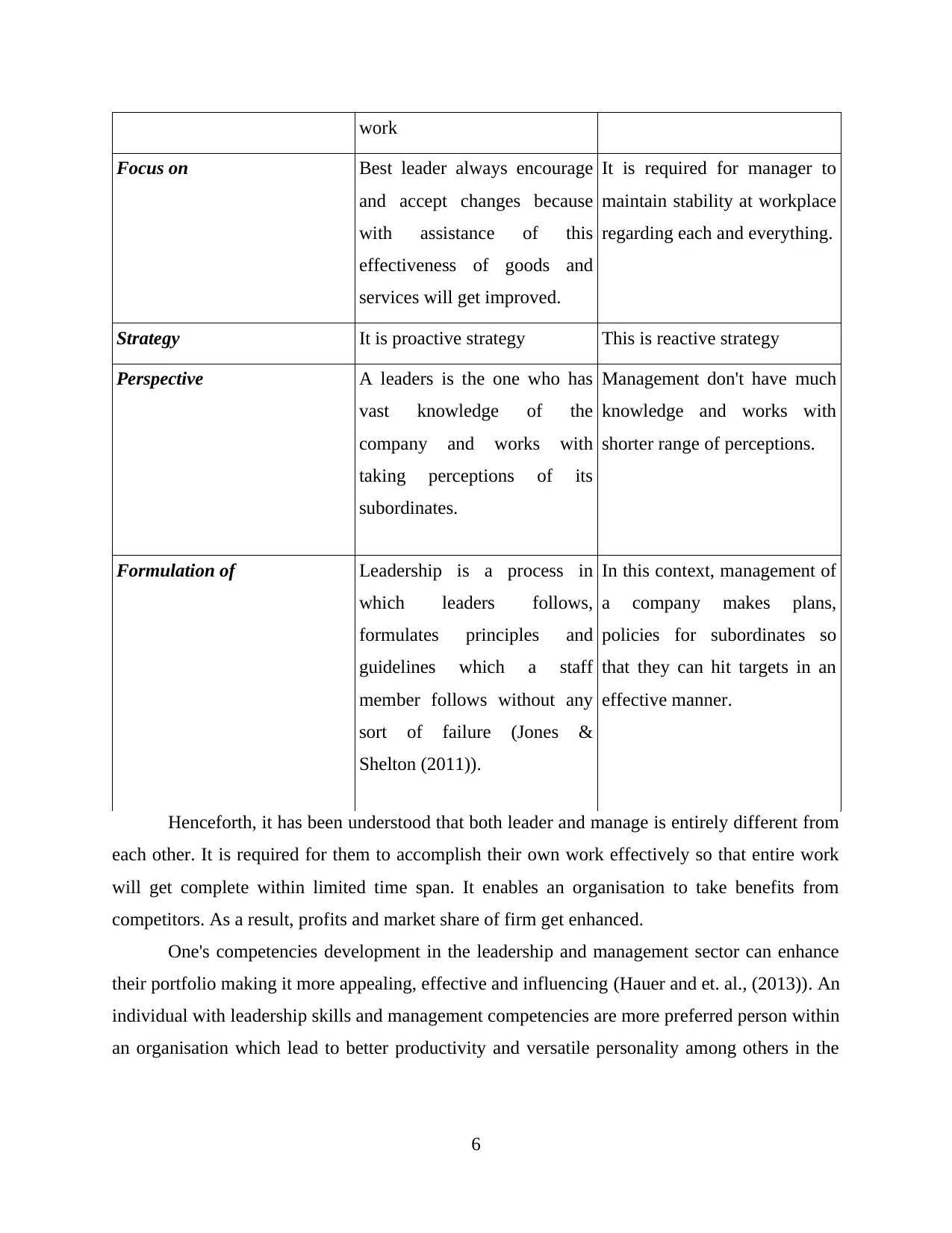
work
Focus on Best leader always encourage
and accept changes because
with assistance of this
effectiveness of goods and
services will get improved.
It is required for manager to
maintain stability at workplace
regarding each and everything.
Strategy It is proactive strategy This is reactive strategy
Perspective A leaders is the one who has
vast knowledge of the
company and works with
taking perceptions of its
subordinates.
Management don't have much
knowledge and works with
shorter range of perceptions.
Formulation of Leadership is a process in
which leaders follows,
formulates principles and
guidelines which a staff
member follows without any
sort of failure (Jones &
Shelton (2011)).
In this context, management of
a company makes plans,
policies for subordinates so
that they can hit targets in an
effective manner.
Henceforth, it has been understood that both leader and manage is entirely different from
each other. It is required for them to accomplish their own work effectively so that entire work
will get complete within limited time span. It enables an organisation to take benefits from
competitors. As a result, profits and market share of firm get enhanced.
One's competencies development in the leadership and management sector can enhance
their portfolio making it more appealing, effective and influencing (Hauer and et. al., (2013)). An
individual with leadership skills and management competencies are more preferred person within
an organisation which lead to better productivity and versatile personality among others in the
6
Focus on Best leader always encourage
and accept changes because
with assistance of this
effectiveness of goods and
services will get improved.
It is required for manager to
maintain stability at workplace
regarding each and everything.
Strategy It is proactive strategy This is reactive strategy
Perspective A leaders is the one who has
vast knowledge of the
company and works with
taking perceptions of its
subordinates.
Management don't have much
knowledge and works with
shorter range of perceptions.
Formulation of Leadership is a process in
which leaders follows,
formulates principles and
guidelines which a staff
member follows without any
sort of failure (Jones &
Shelton (2011)).
In this context, management of
a company makes plans,
policies for subordinates so
that they can hit targets in an
effective manner.
Henceforth, it has been understood that both leader and manage is entirely different from
each other. It is required for them to accomplish their own work effectively so that entire work
will get complete within limited time span. It enables an organisation to take benefits from
competitors. As a result, profits and market share of firm get enhanced.
One's competencies development in the leadership and management sector can enhance
their portfolio making it more appealing, effective and influencing (Hauer and et. al., (2013)). An
individual with leadership skills and management competencies are more preferred person within
an organisation which lead to better productivity and versatile personality among others in the
6
⊘ This is a preview!⊘
Do you want full access?
Subscribe today to unlock all pages.

Trusted by 1+ million students worldwide
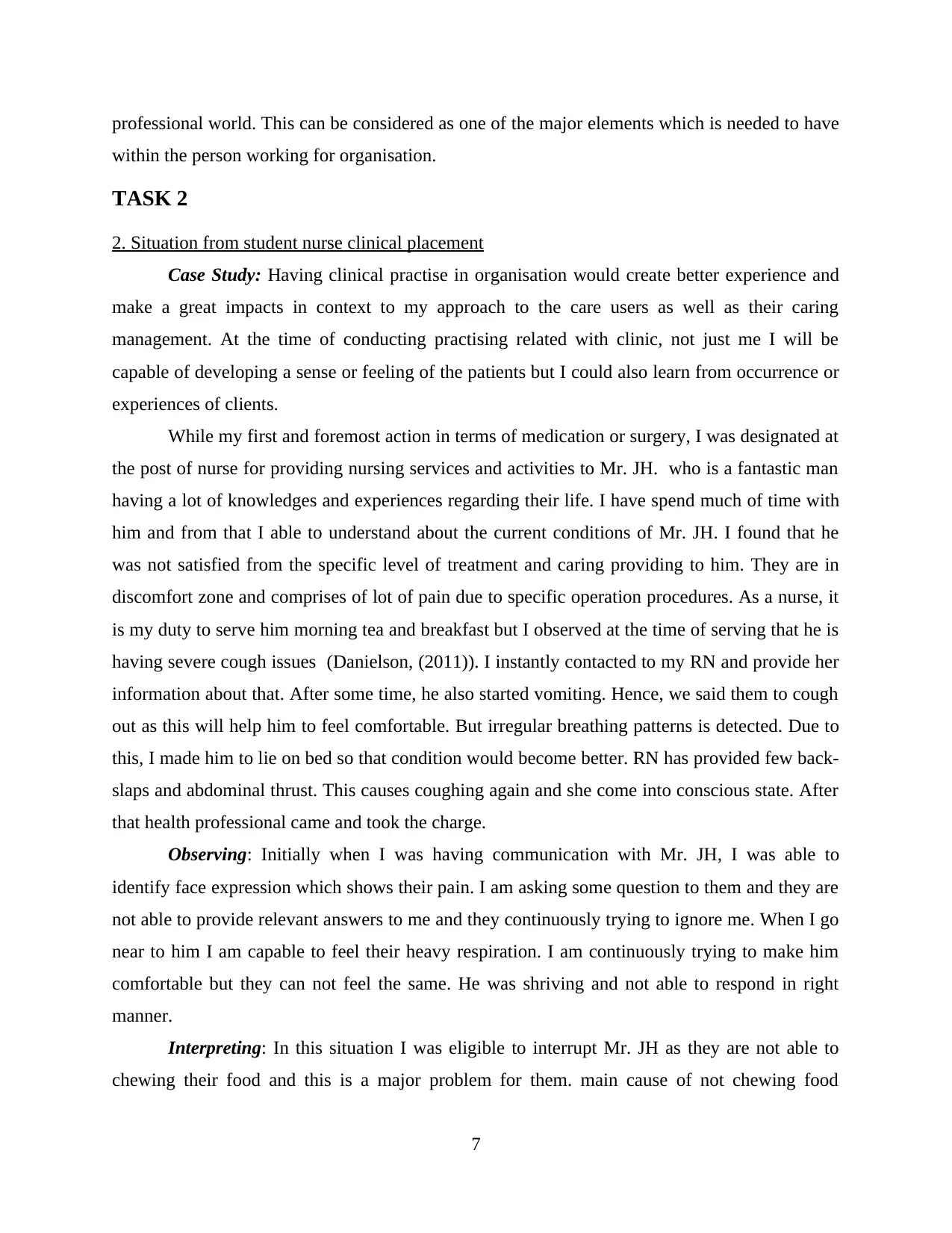
professional world. This can be considered as one of the major elements which is needed to have
within the person working for organisation.
TASK 2
2. Situation from student nurse clinical placement
Case Study: Having clinical practise in organisation would create better experience and
make a great impacts in context to my approach to the care users as well as their caring
management. At the time of conducting practising related with clinic, not just me I will be
capable of developing a sense or feeling of the patients but I could also learn from occurrence or
experiences of clients.
While my first and foremost action in terms of medication or surgery, I was designated at
the post of nurse for providing nursing services and activities to Mr. JH. who is a fantastic man
having a lot of knowledges and experiences regarding their life. I have spend much of time with
him and from that I able to understand about the current conditions of Mr. JH. I found that he
was not satisfied from the specific level of treatment and caring providing to him. They are in
discomfort zone and comprises of lot of pain due to specific operation procedures. As a nurse, it
is my duty to serve him morning tea and breakfast but I observed at the time of serving that he is
having severe cough issues (Danielson, (2011)). I instantly contacted to my RN and provide her
information about that. After some time, he also started vomiting. Hence, we said them to cough
out as this will help him to feel comfortable. But irregular breathing patterns is detected. Due to
this, I made him to lie on bed so that condition would become better. RN has provided few back-
slaps and abdominal thrust. This causes coughing again and she come into conscious state. After
that health professional came and took the charge.
Observing: Initially when I was having communication with Mr. JH, I was able to
identify face expression which shows their pain. I am asking some question to them and they are
not able to provide relevant answers to me and they continuously trying to ignore me. When I go
near to him I am capable to feel their heavy respiration. I am continuously trying to make him
comfortable but they can not feel the same. He was shriving and not able to respond in right
manner.
Interpreting: In this situation I was eligible to interrupt Mr. JH as they are not able to
chewing their food and this is a major problem for them. main cause of not chewing food
7
within the person working for organisation.
TASK 2
2. Situation from student nurse clinical placement
Case Study: Having clinical practise in organisation would create better experience and
make a great impacts in context to my approach to the care users as well as their caring
management. At the time of conducting practising related with clinic, not just me I will be
capable of developing a sense or feeling of the patients but I could also learn from occurrence or
experiences of clients.
While my first and foremost action in terms of medication or surgery, I was designated at
the post of nurse for providing nursing services and activities to Mr. JH. who is a fantastic man
having a lot of knowledges and experiences regarding their life. I have spend much of time with
him and from that I able to understand about the current conditions of Mr. JH. I found that he
was not satisfied from the specific level of treatment and caring providing to him. They are in
discomfort zone and comprises of lot of pain due to specific operation procedures. As a nurse, it
is my duty to serve him morning tea and breakfast but I observed at the time of serving that he is
having severe cough issues (Danielson, (2011)). I instantly contacted to my RN and provide her
information about that. After some time, he also started vomiting. Hence, we said them to cough
out as this will help him to feel comfortable. But irregular breathing patterns is detected. Due to
this, I made him to lie on bed so that condition would become better. RN has provided few back-
slaps and abdominal thrust. This causes coughing again and she come into conscious state. After
that health professional came and took the charge.
Observing: Initially when I was having communication with Mr. JH, I was able to
identify face expression which shows their pain. I am asking some question to them and they are
not able to provide relevant answers to me and they continuously trying to ignore me. When I go
near to him I am capable to feel their heavy respiration. I am continuously trying to make him
comfortable but they can not feel the same. He was shriving and not able to respond in right
manner.
Interpreting: In this situation I was eligible to interrupt Mr. JH as they are not able to
chewing their food and this is a major problem for them. main cause of not chewing food
7
Paraphrase This Document
Need a fresh take? Get an instant paraphrase of this document with our AI Paraphraser
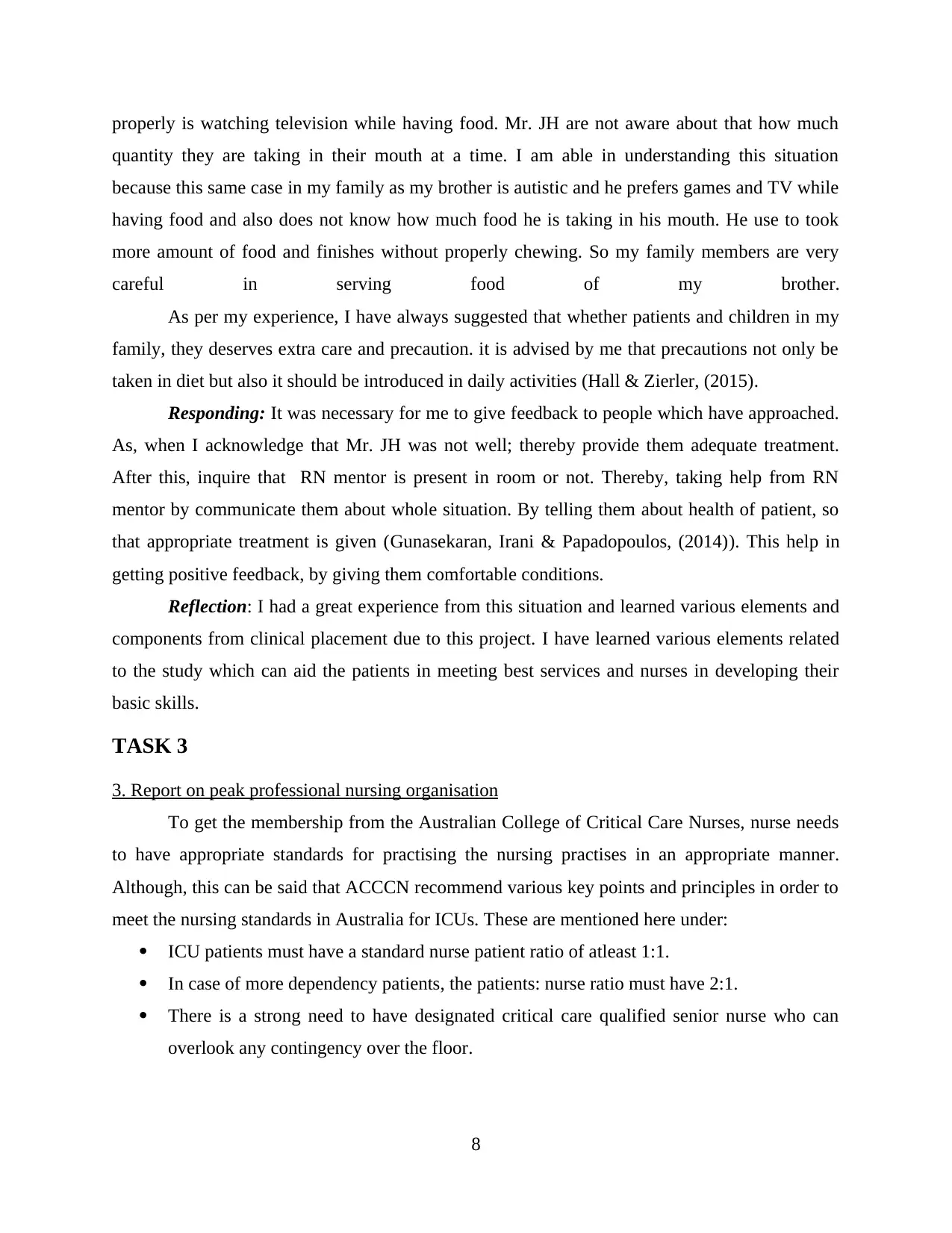
properly is watching television while having food. Mr. JH are not aware about that how much
quantity they are taking in their mouth at a time. I am able in understanding this situation
because this same case in my family as my brother is autistic and he prefers games and TV while
having food and also does not know how much food he is taking in his mouth. He use to took
more amount of food and finishes without properly chewing. So my family members are very
careful in serving food of my brother.
As per my experience, I have always suggested that whether patients and children in my
family, they deserves extra care and precaution. it is advised by me that precautions not only be
taken in diet but also it should be introduced in daily activities (Hall & Zierler, (2015).
Responding: It was necessary for me to give feedback to people which have approached.
As, when I acknowledge that Mr. JH was not well; thereby provide them adequate treatment.
After this, inquire that RN mentor is present in room or not. Thereby, taking help from RN
mentor by communicate them about whole situation. By telling them about health of patient, so
that appropriate treatment is given (Gunasekaran, Irani & Papadopoulos, (2014)). This help in
getting positive feedback, by giving them comfortable conditions.
Reflection: I had a great experience from this situation and learned various elements and
components from clinical placement due to this project. I have learned various elements related
to the study which can aid the patients in meeting best services and nurses in developing their
basic skills.
TASK 3
3. Report on peak professional nursing organisation
To get the membership from the Australian College of Critical Care Nurses, nurse needs
to have appropriate standards for practising the nursing practises in an appropriate manner.
Although, this can be said that ACCCN recommend various key points and principles in order to
meet the nursing standards in Australia for ICUs. These are mentioned here under:
ICU patients must have a standard nurse patient ratio of atleast 1:1.
In case of more dependency patients, the patients: nurse ratio must have 2:1.
There is a strong need to have designated critical care qualified senior nurse who can
overlook any contingency over the floor.
8
quantity they are taking in their mouth at a time. I am able in understanding this situation
because this same case in my family as my brother is autistic and he prefers games and TV while
having food and also does not know how much food he is taking in his mouth. He use to took
more amount of food and finishes without properly chewing. So my family members are very
careful in serving food of my brother.
As per my experience, I have always suggested that whether patients and children in my
family, they deserves extra care and precaution. it is advised by me that precautions not only be
taken in diet but also it should be introduced in daily activities (Hall & Zierler, (2015).
Responding: It was necessary for me to give feedback to people which have approached.
As, when I acknowledge that Mr. JH was not well; thereby provide them adequate treatment.
After this, inquire that RN mentor is present in room or not. Thereby, taking help from RN
mentor by communicate them about whole situation. By telling them about health of patient, so
that appropriate treatment is given (Gunasekaran, Irani & Papadopoulos, (2014)). This help in
getting positive feedback, by giving them comfortable conditions.
Reflection: I had a great experience from this situation and learned various elements and
components from clinical placement due to this project. I have learned various elements related
to the study which can aid the patients in meeting best services and nurses in developing their
basic skills.
TASK 3
3. Report on peak professional nursing organisation
To get the membership from the Australian College of Critical Care Nurses, nurse needs
to have appropriate standards for practising the nursing practises in an appropriate manner.
Although, this can be said that ACCCN recommend various key points and principles in order to
meet the nursing standards in Australia for ICUs. These are mentioned here under:
ICU patients must have a standard nurse patient ratio of atleast 1:1.
In case of more dependency patients, the patients: nurse ratio must have 2:1.
There is a strong need to have designated critical care qualified senior nurse who can
overlook any contingency over the floor.
8
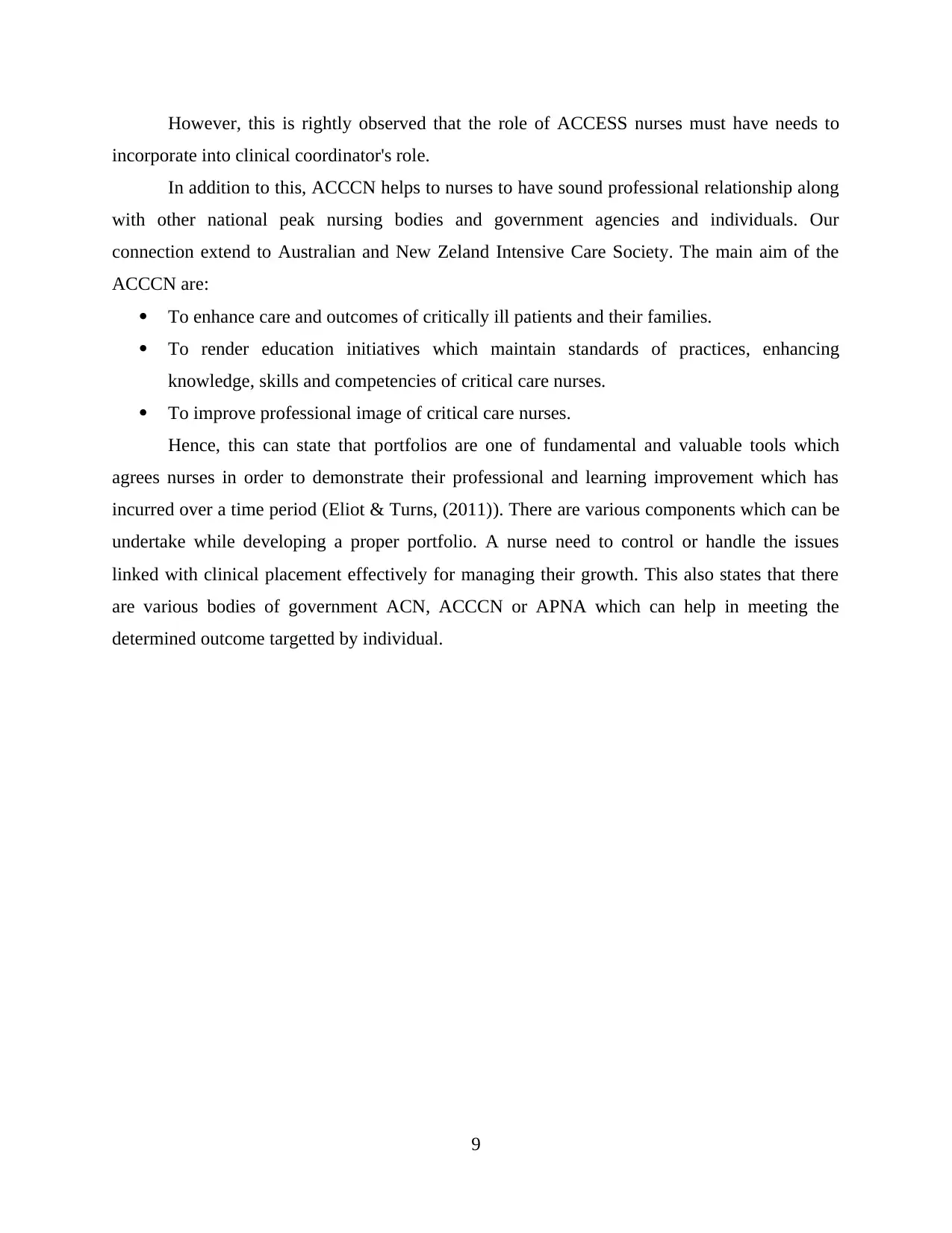
However, this is rightly observed that the role of ACCESS nurses must have needs to
incorporate into clinical coordinator's role.
In addition to this, ACCCN helps to nurses to have sound professional relationship along
with other national peak nursing bodies and government agencies and individuals. Our
connection extend to Australian and New Zeland Intensive Care Society. The main aim of the
ACCCN are:
To enhance care and outcomes of critically ill patients and their families.
To render education initiatives which maintain standards of practices, enhancing
knowledge, skills and competencies of critical care nurses.
To improve professional image of critical care nurses.
Hence, this can state that portfolios are one of fundamental and valuable tools which
agrees nurses in order to demonstrate their professional and learning improvement which has
incurred over a time period (Eliot & Turns, (2011)). There are various components which can be
undertake while developing a proper portfolio. A nurse need to control or handle the issues
linked with clinical placement effectively for managing their growth. This also states that there
are various bodies of government ACN, ACCCN or APNA which can help in meeting the
determined outcome targetted by individual.
9
incorporate into clinical coordinator's role.
In addition to this, ACCCN helps to nurses to have sound professional relationship along
with other national peak nursing bodies and government agencies and individuals. Our
connection extend to Australian and New Zeland Intensive Care Society. The main aim of the
ACCCN are:
To enhance care and outcomes of critically ill patients and their families.
To render education initiatives which maintain standards of practices, enhancing
knowledge, skills and competencies of critical care nurses.
To improve professional image of critical care nurses.
Hence, this can state that portfolios are one of fundamental and valuable tools which
agrees nurses in order to demonstrate their professional and learning improvement which has
incurred over a time period (Eliot & Turns, (2011)). There are various components which can be
undertake while developing a proper portfolio. A nurse need to control or handle the issues
linked with clinical placement effectively for managing their growth. This also states that there
are various bodies of government ACN, ACCCN or APNA which can help in meeting the
determined outcome targetted by individual.
9
⊘ This is a preview!⊘
Do you want full access?
Subscribe today to unlock all pages.

Trusted by 1+ million students worldwide
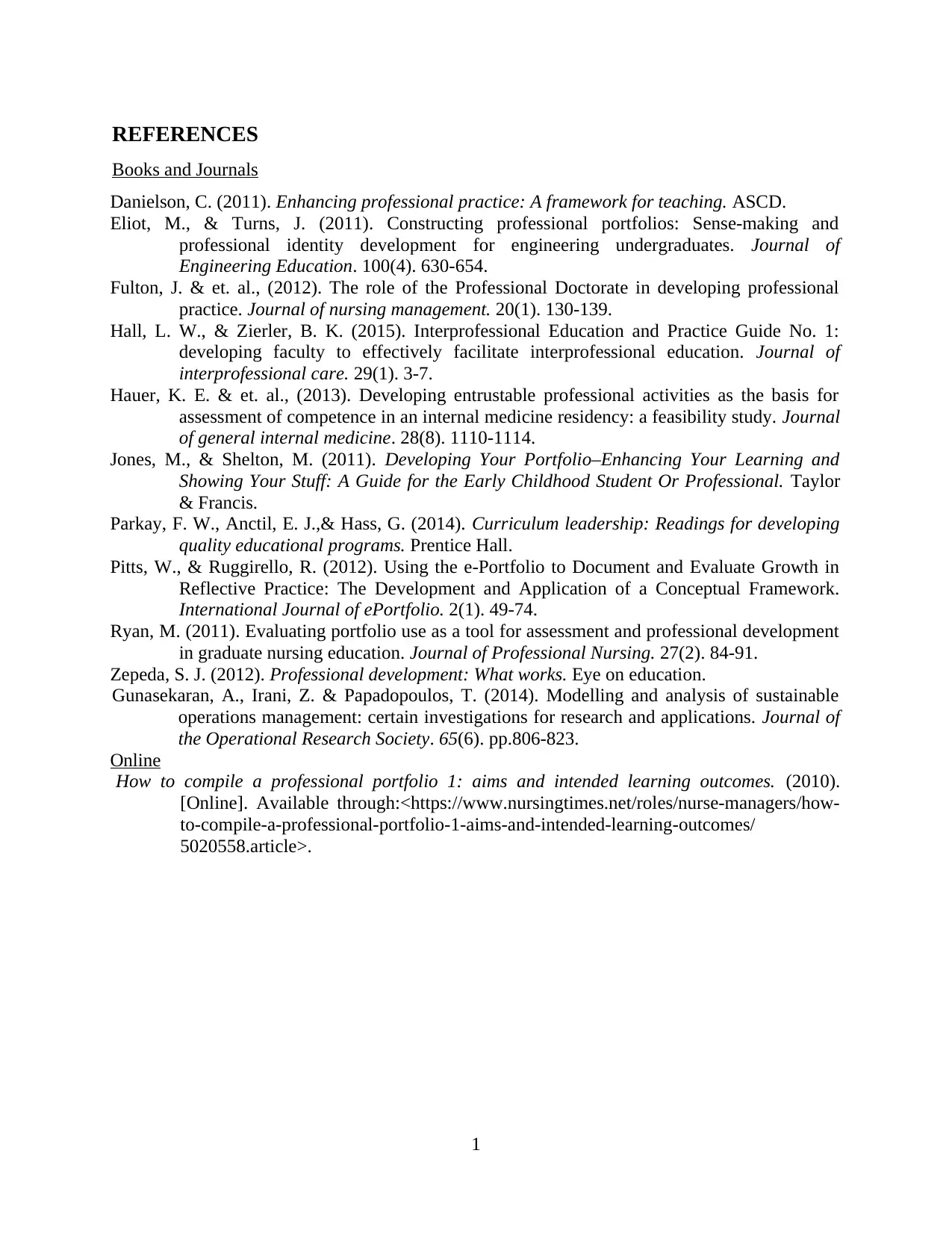
REFERENCES
Books and Journals
Danielson, C. (2011). Enhancing professional practice: A framework for teaching. ASCD.
Eliot, M., & Turns, J. (2011). Constructing professional portfolios: Sense‐making and
professional identity development for engineering undergraduates. Journal of
Engineering Education. 100(4). 630-654.
Fulton, J. & et. al., (2012). The role of the Professional Doctorate in developing professional
practice. Journal of nursing management. 20(1). 130-139.
Hall, L. W., & Zierler, B. K. (2015). Interprofessional Education and Practice Guide No. 1:
developing faculty to effectively facilitate interprofessional education. Journal of
interprofessional care. 29(1). 3-7.
Hauer, K. E. & et. al., (2013). Developing entrustable professional activities as the basis for
assessment of competence in an internal medicine residency: a feasibility study. Journal
of general internal medicine. 28(8). 1110-1114.
Jones, M., & Shelton, M. (2011). Developing Your Portfolio–Enhancing Your Learning and
Showing Your Stuff: A Guide for the Early Childhood Student Or Professional. Taylor
& Francis.
Parkay, F. W., Anctil, E. J.,& Hass, G. (2014). Curriculum leadership: Readings for developing
quality educational programs. Prentice Hall.
Pitts, W., & Ruggirello, R. (2012). Using the e-Portfolio to Document and Evaluate Growth in
Reflective Practice: The Development and Application of a Conceptual Framework.
International Journal of ePortfolio. 2(1). 49-74.
Ryan, M. (2011). Evaluating portfolio use as a tool for assessment and professional development
in graduate nursing education. Journal of Professional Nursing. 27(2). 84-91.
Zepeda, S. J. (2012). Professional development: What works. Eye on education.
Gunasekaran, A., Irani, Z. & Papadopoulos, T. (2014). Modelling and analysis of sustainable
operations management: certain investigations for research and applications. Journal of
the Operational Research Society. 65(6). pp.806-823.
Online
How to compile a professional portfolio 1: aims and intended learning outcomes. (2010).
[Online]. Available through:<https://www.nursingtimes.net/roles/nurse-managers/how-
to-compile-a-professional-portfolio-1-aims-and-intended-learning-outcomes/
5020558.article>.
1
Books and Journals
Danielson, C. (2011). Enhancing professional practice: A framework for teaching. ASCD.
Eliot, M., & Turns, J. (2011). Constructing professional portfolios: Sense‐making and
professional identity development for engineering undergraduates. Journal of
Engineering Education. 100(4). 630-654.
Fulton, J. & et. al., (2012). The role of the Professional Doctorate in developing professional
practice. Journal of nursing management. 20(1). 130-139.
Hall, L. W., & Zierler, B. K. (2015). Interprofessional Education and Practice Guide No. 1:
developing faculty to effectively facilitate interprofessional education. Journal of
interprofessional care. 29(1). 3-7.
Hauer, K. E. & et. al., (2013). Developing entrustable professional activities as the basis for
assessment of competence in an internal medicine residency: a feasibility study. Journal
of general internal medicine. 28(8). 1110-1114.
Jones, M., & Shelton, M. (2011). Developing Your Portfolio–Enhancing Your Learning and
Showing Your Stuff: A Guide for the Early Childhood Student Or Professional. Taylor
& Francis.
Parkay, F. W., Anctil, E. J.,& Hass, G. (2014). Curriculum leadership: Readings for developing
quality educational programs. Prentice Hall.
Pitts, W., & Ruggirello, R. (2012). Using the e-Portfolio to Document and Evaluate Growth in
Reflective Practice: The Development and Application of a Conceptual Framework.
International Journal of ePortfolio. 2(1). 49-74.
Ryan, M. (2011). Evaluating portfolio use as a tool for assessment and professional development
in graduate nursing education. Journal of Professional Nursing. 27(2). 84-91.
Zepeda, S. J. (2012). Professional development: What works. Eye on education.
Gunasekaran, A., Irani, Z. & Papadopoulos, T. (2014). Modelling and analysis of sustainable
operations management: certain investigations for research and applications. Journal of
the Operational Research Society. 65(6). pp.806-823.
Online
How to compile a professional portfolio 1: aims and intended learning outcomes. (2010).
[Online]. Available through:<https://www.nursingtimes.net/roles/nurse-managers/how-
to-compile-a-professional-portfolio-1-aims-and-intended-learning-outcomes/
5020558.article>.
1
1 out of 10
Related Documents
Your All-in-One AI-Powered Toolkit for Academic Success.
+13062052269
info@desklib.com
Available 24*7 on WhatsApp / Email
![[object Object]](/_next/static/media/star-bottom.7253800d.svg)
Unlock your academic potential
Copyright © 2020–2025 A2Z Services. All Rights Reserved. Developed and managed by ZUCOL.





